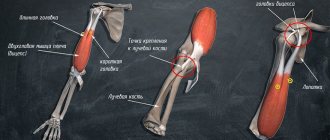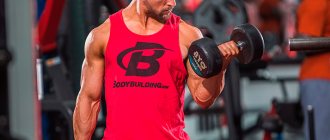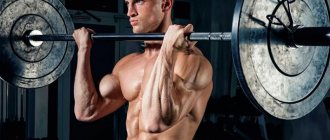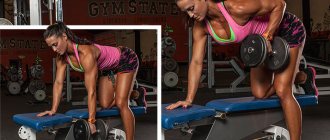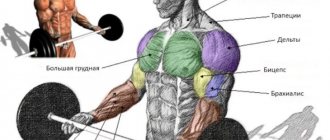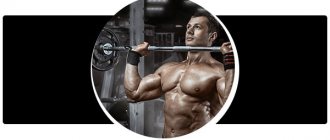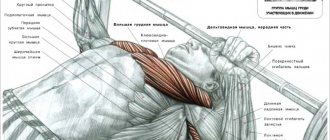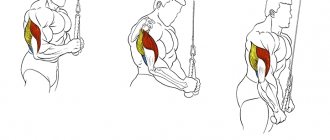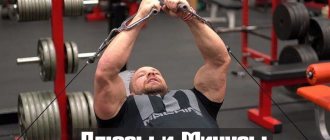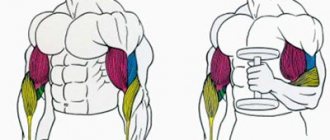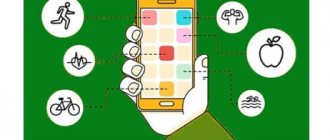Scott Bench Curl with Dumbbell
Any beginner knows that the biceps curl works the biceps as the main muscle group.
And Scott's bench is no exception. The brachialis acts as an assistant muscle. This is a small but very strong muscle. It helps the biceps flex the arm. It is especially strongly included in the initial phase of movement. If you change your grip a little, you can shift the emphasis to working on the brachialis. The muscles of the forearm are responsible for supporting weight. These are all kinds of finger flexors.
But judging from this anatomy, it is not entirely clear how this exercise differs from the same ARM BENDINGS WITH A BARbell IN A STANDING position. And is there any point in doing it at all?
The dumbbell curl on the Scott bench is an isolation exercise aimed at working the biceps and brachialis muscles, especially the outer part, giving an expressive look to the arm in the area where the biceps meets the triceps.
The very first Mr. Olympia title was won by Larry Scott, who was distinguished by his large arms. Nowadays, many bodybuilders have large biceps. Certain pharmacological drugs help them with this.
However, at the time Larry Scott began his career (in the early 60s), steroids were not yet well known. Therefore, Larry achieved significant muscle volume in his arms as a result of his own efforts without the help of steroids.
He purposefully worked with various programs, and if he did not see results, he immediately changed them. Scott experimented a lot, trying everything he could in his training. And as a result, three years later, one of the most famous exercise machines appeared, which was called the “Scott bench.”
Larry Scott, who had huge hands, will not give bad advice. Therefore, we recommend using the dumbbell curl on the Scott bench in your training program, since the exercise is very effective.
The advantage of exercises performed with one arm is that there is no artificial assistance to the weaker arm at the expense of the stronger one, as in exercises with a barbell.
In addition, with their help, power imbalances are well balanced.
To perform the exercise you will need the following equipment:
- Scott's bench (The inventor of the exercise machine himself used the term “lectern”; the exercise is, respectively, bending an arm with a dumbbell on a Scott’s bench).
- Take a dumbbell and place your hand on top of the bench. Try not to raise your shoulder and keep your wrist firm. Slowly extend your arm, but not all the way, 75-85 percent, until you feel a stretch in the biceps area, then twist your hand and bend your arm.
- The most important rule here is isolation. The hand in which you hold the dumbbell is isolated so that you cannot help yourself with your body even if you want.
- Raise the dumbbell up to your head and hold the position where your forearm is almost perpendicular to the floor. You bend your arm not in the direction of the torso, but to the side, while simultaneously supinating the hand, which further moves the weight away from the body. Squeeze your biceps to achieve maximum contraction at the peak and return to the starting position, slightly shortening your arm until the elbow joint is completely relaxed.
- Since the arm position is rigid and the biceps are isolated, do not try to fully extend the arm at the bottom of the movement.
- Perform curls using the strength of your biceps, not your hands.
- Once you reach failure, take a hammer grip and continue the exercise for as many repetitions as possible. So, along with the biceps, the muscles of the forearm are also involved.
- But don’t chase too much weight—it won’t do you any good.
Believe me, you won't find a better exercise when it comes to feeling peak contractions!
The key advantage of this exercise is the ability to focus and isolate the biceps and brachialis. Benefits of performing biceps curls on a Scott bench:
- Exercise leads to active growth of muscle mass and an increase in the volume and strength of the arms.
- It assumes quite a lot of variability in terms of the choice of projectile and the grip used. Thanks to this, you can shift the emphasis of the load from the center to the outer or inner head of the muscle.
- Does not create excessive stress on the wrists when working with a curved bar.
- Allows you to work with heavy weights. However, in this case you will need the help of a partner, since taking the desired position yourself with a heavy projectile in your hands is inconvenient and unsafe.
Lifting the barbell on a Scott bench is contraindicated for injuries to the elbow joints. Also, if you are doing reverse grip biceps curls, use less weight than in the classic version of the exercise.
Execution technique
Select a projectile of the required weight. For example, this could be a barbell with an EZ bar. Adjust the height of the “shelf” to suit your height.
- Sit on a bench and place your feet firmly on the floor. Grasp the barbell with an underhand grip (palms facing) and place your hands on the bar parallel to each other, shoulder-width apart. If you are an experienced athlete and lift heavy weights, sit down and ask an assistant to hand you the apparatus.
- In the starting position, the arms are lowered down and the elbows are minimally bent. There is no need to fully extend them throughout the entire exercise. The hands are fixed and slightly tucked inward. Take a deep breath.
- As you exhale, curl your arms. At the final point, do not bring your arms to a position perpendicular to the floor. There should be some space between the hands and shoulders. When the forearms are vertical, some of the load is lost. Stay at this point for 1-2 seconds.
- As you inhale, smoothly return your arms to the starting position.
An important technical point: never “throw” the projectile sharply down. At the point of extreme extension with weight, your elbows experience serious stress. Avoid this traumatic exposure.
Using an EZ bar.
BICEPS: external and internal heads (bundles)
- If you use a narrow grip, the load goes to the outer biceps.
- If you use a wide grip = load on the inner biceps.
However, due to the nature of this exercise, namely: the elbows are brought forward, in any case, most of the load will come to the inner biceps.
Therefore, in my humble opinion)) the grip is not particularly important... when I performed this exercise, I worked with a narrow grip (or such a medium one), because it was physiologically COMFORTABLE for me. In general, see for yourself...
- Warm up your muscles and joints well.
- Prepare a straight bar of the required weight by placing it on special bench racks.
Step-by-step exercise algorithm:
- First, while standing, grab the bar with a shoulder-width grip, then sit on the bench, resting your elbows on the armrest, and lift the bar.
- Feet rest on the floor.
- Take a comfortable sitting position, having previously adjusted the seat height according to your height so that your shoulders do not ride up on the back of the machine, rest your chest.
- Exhale: Perform barbell curls on a Scott bench, squeezing your biceps as much as possible at the top.
- Inhale: slowly lower your arms without fully extending your elbows - this will prevent joint injuries and strained tendons.
- Work with moderate weight, as the muscles and ligaments are under a lot of tension. Choose a comfortable weight for 8-12 repetitions, perform 4 sets. It is advisable to work with an assistant; on the last difficult repetitions, the insurer, with a little effort, will help to qualitatively refine the approach.
- On the last rep, slowly straighten your arms, lift yourself up and lower the bar onto the racks, then rest for 2 minutes. It is advisable to stretch the muscles by pressing with one hand on the wrist with the second palm turned away from you, feeling the stretch of the biceps, and change.
Analysis of the exercise
The Scott Bench Curl is an isolated strength exercise that exclusively targets the biceps brachii muscle. It is usually used as an auxiliary tool for the formation of biceps density and relief.
When performing a movement, the load falls on both muscle bundles with an emphasis on the short head. To a lesser extent, when performing bending, the brachialis is included in the work, as well as, depending on the position of the arms, the brachialis, radiobrachialis and pronator teres muscles.
What's the plus?
The Scott Bench Curl has better biceps development potential than other isolation movements. Its high efficiency is determined precisely by the use of a bench, which eliminates any possibility of cheating.
Inclusion in the training program
The exercise is most often included in the final part of the workout for a “finishing” effect on the muscle. In this case, it is most appropriate to perform it in mode 1 approach “to failure”.
If you prefer to include the exercise in the middle part of the program, the optimal solution would be to perform it in the range of 6-12 repetitions in 3-4 sets. Before performing the movement in both cases, it is necessary to do a warm-up set with minimal weight.
Carefully choose the weight - work with a weight that allows you to perform the planned number of repetitions efficiently.
Execution nuances
- Changing the grip width of the barbell, although not critical, still affects the direction of the workload. Thus, a narrow grip shifts the emphasis to the long head of the biceps, while a wide stance uses the inner bundle of the muscle more.
- When the arm is fully bent at the elbow at the top point of the movement, the biceps is “switched off” from work, which significantly reduces the efficiency of the exercise.
- To increase the efficiency of the movement, perform the negative phase slowly (4 seconds); on the “positive” rise, increase the pace to 2 seconds.
- The hammer grip of dumbbells allows you to develop your brachialis well.
Cautions
- It is not permissible to use heavy weights for this exercise, since in this case it is more difficult to control the range of motion.
- Full-amplitude bending is considered traumatic, since a large load falls on the elbows, and excessive tension occurs in the tendons. To avoid this, maintain a slight bend in your elbow at the bottom of the movement.
- It is recommended that this exercise be excluded from the program for athletes with previously injured elbow joints.
Interesting fact
Bench curls were invented by the first Mr. Olympia, after whom the exercise was named - Larry Scott. Confident of the unparalleled effectiveness of the isolation movement, he included it in the “core” of biceps training.
Errors
»
At the lowest point, the arms are lowered completely, but a slight “bend” in the elbow joint is maintained due to the hands being tucked “towards oneself”
»
Sit straight on the bench, do not help bend the weight with your biceps with your back and legs
»
Elbows should be pressed tightly against the bench at all times.
»
The weight rises and falls without sudden movements, smoothly and under control
»
Do a peak contraction at the top of the amplitude with a delay
»
Do not hang large or dangerous weights
How can you replace curling your arms on a Scott bench?
The biceps curl exercise on the Scott bench can be replaced with a standing biceps curl or a block biceps curl.
What is better to choose for curling on Scott: dumbbells or a barbell?
It is necessary to perform extensions on this machine alternating with both dumbbells and a barbell, why? If you bend only with a barbell, in a fixed position and with a given trajectory, the weight will begin to move towards one of the hands. The stronger hand will take more load, that’s all. By bending alternately, you add variety and can give both arms the same load, thus varying and pumping up the weaker arm.
In general, biceps love variety, like other muscle groups. The more often you change the width of your grip, dumbbells or barbell, and the angles of inclination, the better and more positive it affects the growth of muscles that do not have time to adapt to monotonous loads.
More hand exercises:
Hammer with dumbbells for biceps
Number of approaches and repetitions
» For men:
8 - 10 repetitions 3-4 sets.
» For women:
6 - 8 repetitions 3 sets.
What do bends give?
Lifting the barbell on a Scott bench is contraindicated for injuries to the elbow joints. Also, if you are doing reverse grip biceps curls, use less weight than in the classic version of the exercise.
Execution technique
- Sit on a bench and place your feet firmly on the floor. Grab the barbell with an underhand grip (palms facing up), and place your hands on the bar parallel to each other, shoulder-width apart. If you are an experienced athlete and lift heavy weights, sit down and ask an assistant to hand you the apparatus.
- In the starting position, the arms are lowered down and the elbows are minimally bent. There is no need to fully extend them throughout the entire exercise. The hands are fixed and slightly tucked inward. Take a deep breath.
- As you exhale, curl your arms. At the final point, do not bring your arms to a position perpendicular to the floor. There should be some space between the hands and shoulders. When the forearms are vertical, some of the load is lost. Stay at this point for 1-2 seconds.
- As you inhale, smoothly return your arms to the starting position.
Different grips
Curling your arms in the Scott simulator can be done not only with different implements, but also with different grips. For example, a narrow grip best loads the outer head of the biceps, while a wide grip best loads the inner head. A shoulder-width grip works the muscle evenly. Raising the biceps with a reverse grip (palms on top) shifts the emphasis of the load to the forearm muscle - brachioradialis.
Use 2-3 sets of 8-12 reps per exercise. It is recommended to combine it, for example, with barbell curls. Biceps curls are quite energy-intensive, but not the main exercise. It can be done in the middle or at the end of your workout.
If the sports club you visit has the necessary equipment, you can also perform bicep curls in a machine. In essence, the mechanics of the movements are similar to the Scott bench, but instead of a barbell or dumbbells, you pull special handles. The trajectory of the brushes in this case will be fixed.
Today I’ll tell you about the exercise - curling the arms on a Scott bench with a barbell / dumbbells: what it develops, what advantages/disadvantages it has, all the subtleties/secrets, tricks, nuances, etc. and so on.
Bicep curls on a Scott bench are an ISOLATING exercise (since it involves only one joint - the ELBOW) aimed at working the biceps brachii muscle, i.e. BICEPS!
This is an extremely important paragraph in this article, indicating that this exercise is not suitable for building muscle mass in the arms (biceps).
It’s not suitable because isolated exercises load only one specific muscle (in our case, in this exercise (I repeat) - the biceps), therefore, the mechanics of these movements are simply not sufficient to stimulate the growth of the muscle(s)... you know?
In other words, your trips to the gym and the use of isolation exercises there in the hope of “pumping up” are equated to zero, which is why everyone squeals that you need to do the BASIC, that the BASE is the head of everything, etc. etc.)), and all because the base, unlike isolation, requires a lot of physical labor of the whole body and the work of several joints, and the more muscles are involved in the work, the better for the overall development of muscle mass (better muscle growth occurs) .
In addition, you cannot use large (heavy) weights in this exercise because you can easily injure your precious ligaments...
on the left - pull-ups with a reverse biceps grip; on the right - lifting the barbell onto the biceps
Ps I recommend using the EZ bar, because... it is as convenient as possible (comfortable), in addition, it removes part of the load from our forearms and, accordingly, the forearms steal less load (get less tired) and, accordingly, the banks work more (i.e. biceps).
Execution Sequence
1. Before starting to do the bends, set the height of the machine that is comfortable for your arms to place your hands 2. Sit on the bench and take the bent bar with a “palms facing you” grip shoulder-width apart 3. Straighten your back, rest your feet well, bend your arms slightly at the elbows 4 .Take a deep breath and begin to smoothly lift the barbell, exhaling air 5. At the top point, do not throw the bar all the way, but stop 3/4 of the entire amplitude to maintain tension in the biceps 6. From this position, begin to lower the bar, giving natural resistance 7.V bring the bar to the bottom, stretch your biceps well, but try to maintain a minimum “bend” in your elbows so that the lifting phase does not start from the zero point
Position No. 1
Regulation No. 2
Advantages and disadvantages of curling on a Scott bench
To answer the question above, you need to weigh the pros and cons. And then everyone can decide for themselves whether to perform this type of bending or not.
Advantages
- By resting our elbows on the bench, we isolate the biceps. Thus excluding all other muscles from the movement. Of course, the weight of the bar will have to be reduced. But this will not affect the effectiveness of the exercise in any way. Since isolated exercises involve working on the quality of the muscle, and not lifting heavy weights.
- The long head of the biceps is more involved in flexion. After all, when we bring our elbows in front of the body, it becomes more stretched. And the short one is, on the contrary, compressed. But it’s worth saying right away that the difference in their work is very insignificant. Since it is impossible to bend your arm and strain one of the heads.
- Concentrated biceps work is underway.
- Increasing the volume and improving the relief of the biceps brachii muscle.
- If you don't feel your biceps working, the Scott bench will help fix that. This is especially useful for beginners who do not yet have a stable neuromuscular connection.
- Due to the variety of techniques and grips, we can work all the muscles of the front of the shoulder.
- Availability of this exercise. Even the simplest rooms have a Scott bench. Do you think this is a coincidence? Don't think.
Flaws
- By performing these curls, we will not be able to build muscle mass. Since we will be working with lighter weights.
In a word, if your goal is to give the biceps muscle an expressive shape and increase its volume. Then the Scott Bench will be the best exercise for you to achieve this. During the period of weight gain, it is better to give preference to basic exercises.
We pump up massive biceps on the Scott bench by lifting barbells and dumbbells
I continue my story about Bret Contreras’ research on the best exercises for gaining biceps muscle mass.
In the first part of the article, I talked about three exercises, the high effectiveness of which was demonstrated by a medical device called an electromyograph.
These are pull-ups with a straight and parallel grip, as well as biceps curls with a curved barbell. Today I want to continue the list of the best biceps exercises and talk about two more of them.
At first glance, it seems that there is nothing unusual in this biceps exercise. Almost not. Except for the angle of the bench itself.
Bret Contreras recorded that the muscle in this exercise receives maximum load when the arm rests almost vertically. That is, the angle of the Scott bench should not be 45°, but 70-80°.
This allows you to exclude all other muscles of the body from work, directing maximum load directly to the biceps.
Larry Scott | Inventor of the Scott Bench and the first Mr. Olympia
And that’s when I truly rejoiced. For I myself, without any instruments, came to the same conclusion. It has always been a mystery to me why the angle of all the benches in the gym can be changed, but the Scott bench comes with one angle and is not adjustable?
And I found a way out of this situation - I began to slip a step under the bench. In one biceps workout I place it under the front post of the bench, and in another I place it under the back post. Thus, in spite of the manufacturers of sports equipment, I came close to one of the most effective exercises for biceps. But let's return to Señor Contreras.
So, lifting on a Scott bench gives the greatest impact for gaining muscle mass in the biceps when it is performed at an angle of 70-80°, and even with one hand. I don’t know exactly why one and not two with a barbell. Perhaps the researcher himself will not be able to answer such a question.
I think that this biceps exercise is called the best because the main mass of the biceps brachii muscle creates its largest and most powerful external bundle. The greater his muscle mass, the more massive the biceps itself. And judging by the electromyograph readings, lifting a dumbbell on a Scott bench with one hand maximally loads the external bundle.
Lifting the barbell on a Scott bench
- By locking my body into a rigid frame, I can push myself further, forcing the muscles to work beyond the point of pain.
- I can use more weight in the exercise and cheat.
Scott bench dumbbell raise
- In addition to the normal lift, I can also supinate the wrist, causing the biceps to stretch at the bottom and contract at the top.
- By helping myself with my other hand, I can do a few more forced reps.
In my opinion, only by trying each of these methods of biceps training in the gym, you can understand which of them is the most effective for you, and which one should be included in your set of exercises for biceps for mass.
But I didn’t stop at just lifting barbells and dumbbells and decided to experiment some more. One day, I dragged Scott's bench to the lower block and tried doing cable curls.
Therefore, at some points in the trajectory, the biceps, being in the dead zones, does not work at all.
When bending your arms on a block, the load on the muscles is constant and directed not downward, but at an angle. Carrying Scott's bench to the lower block is not a pleasant task. But to complete your biceps workout, there is no better exercise than isolated cable curls, performed until you feel a strong burning sensation.
This exercise for gaining biceps mass, according to research by Bret Contreras, closes the top five most effective. I periodically tried to do it unsuccessfully until I found out exactly how our fitness expert recommends doing it:
- The word “concentrated” is key in the name of this biceps exercise. This means that the ability to mentally focus on performing it is more important than the weight of the dumbbell.
- The dumbbell needs to not only be lifted, but supinated - twisted, turning it outward, turning the hand to the limit. There is simply no point in performing this biceps exercise without extreme supination.
- There is no need to rush to get out of the peak point of biceps contraction. Having supinated your hand, you need to hold it in this position for at least 2-3 seconds, tense your biceps until numb, and only then lower the dumbbell.
From all this a very simple conclusion follows - concentrated dumbbell lifts will bring the greatest effect if they are done not at the end of the biceps workout, but at the beginning. Perhaps this conclusion will seem controversial to some, but if the usual set of exercises does not allow you to pump up your biceps, maybe it’s time to change it?
I liked this idea, and in my current sets of exercises for biceps, I often put dumbbell lifts with supination in first place. I advise you to try it too.
When I summarized the results of Bret Contreras’s research and made general conclusions, this is what I came up with:
- If I am an ordinary person and I have problems with the growth of muscle mass in my arms, I should constantly make changes to my training program without focusing on the generally accepted sets of biceps exercises. Because as this experiment showed, we live in captivity of stereotypes created by bodybuilders with an ideal physique.
- Supination is one of the keys to building big biceps. Without doing exercises with wrist eversion, we underload the biceps, depriving it of the stimulus to grow.
- By changing the angle of the Scott bench to 70-80°, we stretch the biceps more strongly. This means that the maximum possible range of motion is the second condition for biceps growth.
- The weight of the burden plays a secondary role. In the first place is mental concentration, and in the second place is the time that the muscles spend under load. This means that the number of repetitions in biceps exercises can be safely raised to 12-15 or use the principle of drop sets.
Drop set (from the English drop - reset and set - assign).
The training principle is associated with a gradual decrease in the weight of the burden as you get tired and then perform the exercise.
How to correctly use a drop set in your mass training and about other equally effective Weider principles, read my article: “The ABCs of muscle mass | A fresh look at Vader's principles."
I believe that you should not try to include all the exercises discussed today in every arm workout. The biceps is a small muscle and can be easily overtrained. But when the day comes for a particularly tough, muscle-building biceps workout, I go 100%.
My set of exercises for biceps for mass necessarily includes: a basic exercise, a stretching exercise, one exercise with supination, and one isolating cable exercise.
| Exercise | Approaches | Repetitions |
| Standing barbell curl (drop sets) | 3 | 8-10 |
| Lifting dumbbells with supination | 3 | 10-12 |
| Lifting the barbell on a Scott bench | 3 | 12-15 |
| Lower block biceps curl on a Scott bench | 2 | 15-20 |
I hope that my story about the research of Bret Contreras will be useful to you, give you food for thought and help you pump up your biceps to 50 cm, and maybe more. May the force be with you. And the mass!
Your biceps, cans, or whatever the bros in the gym call them - for many of them, this is the main muscle for which they go there. Massive arms, and the T-shirt should fit them tightly.
Of course, guys who only work on their biceps can be seen a mile away. They completely lack pecs, and you can’t look at their shoulders without tears. Don't be that guy (or gal if big muscles are your goal).
Each muscle group requires working out so that in any part of the body they are equally well expressed. In addition, some of those whom you want to impress are thrilled by your hands, but there are also those who are crazy about a sculpted back, broad shoulders, powerful chest, elastic buttocks, and so on.
- Luckily, the hands are a fairly easy area to work on.
- There are some great biceps brachii exercises that are specifically designed to literally burn out muscle fibers and give you massive biceps.
- One such exercise is the Scott Bench Curl.
- However, if you take it on, do it right.
Otherwise, you are doing nothing more than deceiving yourself, wasting your time, and missing out on opportunities for growth. Let me show you how to properly lift a dumbbell on a Scott bench for the best pump, increased strength, and muscle growth.
You can pump up your biceps on a special machine - the Scott bench. It is designed to train the lower biceps through arm curls. You can work out the required muscle group using a barbell or dumbbells.
The Scott bench is a machine for pumping up the biceps by curling the arms. The famous bodybuilder Larry Scott is known to the sports world as the inventor of this bench. He personally achieved great results in the field of pumping his arms, namely the lower biceps, thanks to this simulator.
Scott curls are a common exercise for building biceps.
You can pump up your biceps on the Scott bench using dumbbells or a barbell. The essence of the exercise is curling the arms while isolating the biceps and working on their density. Thanks to the machine, the body takes the best position so that you can pump up the muscles of the lower biceps. The shoulder sections of the arms are in front of the body. The tilt angle of the working plane is 60-80 degrees.
How to do biceps curls on a Scott bench? Barbell exercise technique:
- The athlete takes a sitting position on the machine, hands are placed on the surface of the bench, the back is slightly bent.
- The barbell is grabbed with your hands.
- The bar is smoothly raised to the level of the chin, bending the arms. The elbows remain motionless.
Execution technique
Execution options
Before you begin performing the Scott Curl. This bench needs to be adjusted. In most halls, we can only change the seat height. But there are also those where the angle of inclination of the platform into which we rest our elbows is adjusted. If you have a bench like this, then you are lucky. Everyone else follows the same rule. We set the seat at such a height that when resting on the platform, our back does not round.
- After we have adjusted everything, we take the barbell in our hands. It is best if someone gives it to you so that you do not change your position. Fortunately, the gyms are full of people, so I think finding an assistant will not be difficult.
- The back is straight, the shoulders are slightly forward.
- Elbows slightly bent.
- We rest our feet on the floor.
Performance:
- Exhale and bend your arms at the elbow joints, lifting the barbell up.
- At the top, pause briefly and tighten your biceps. Give him the opportunity to work statically (a state of maximum tension by holding the weight)
- As you exhale, lower the barbell under control to the starting position. But at the same time, we do not straighten our arms completely, but leave them slightly bent. This will allow us to maintain tension in the biceps.
Our main task is to feel the work of the target muscle group. In this case, biceps. And also squeeze it as much as possible at the top point. This way we will achieve greater returns from this exercise.
It will help you work on each hand separately. And also, it will be easier to control the work of the biceps. But the main advantage is that you can work to your maximum without a partner. When you feel that you can no longer complete a single repetition, simply help yourself with your free hand. Dumbbells can be held either with a classic grip (palm up) or with a neutral grip.
This is another option for targeted treatment of the brachialis. We take the barbell not from below, but from above (palms down). By performing curls on a Scott bench in this style, the weight of the burden will be even less. But this did not reduce the effectiveness. For greater convenience, you can use an EZ bar.
Yes, progress does not stand still. And instead of the usual curls with free weights, it became possible to perform this exercise in a machine. In terms of technology, everything is basically the same. Only now the handle acts as a bar, and instead of disks there are blocks. We can perform bending with both hands and with one.
In the bodybuilding world, there is an opinion that machines are worse than free weights. But if you take a closer look, many professionals use barbells less and less. Therefore, it is better to try it yourself once than to hear it from someone 7 times. And then form your own objective opinion. If you feel that your biceps are working to their maximum potential in the machine. Then this is your exercise.
Don't be afraid to experiment. We are all different, so everyone needs their own individual type of training. Of course, there are general points that must be adhered to.
Technique for performing bench presses on a Scott bench
If you do not follow the correct technique, you can get injured. It is important to adhere to a number of rules, and at the very beginning it is necessary to adjust the position of the bench. In most cases, equipment is only adjustable in height. However, there are also simulators in which you can set the angle of inclination of the platform. The height of the seat should be such that when resting on the platform, a deflection does not form in the back.
Initial position:
- Take the barbell in your hands (it’s better if your partner gives you the apparatus);
- Straighten your back, push your shoulders slightly forward;
- Bend your elbows;
- Place your feet on the floor.
Performing barbell lifts on a Scott bench:
- Exhale, bend your elbows, lift the barbell;
- In the upper position, pause, tense your biceps; hold the weight, feel maximum tension;
- Exhale, carefully lower the barbell to its original position, do not fully extend your arms to maintain slight muscle tension.
Which grip should you choose?
The barbell can be grabbed with different grips. This determines the load displacement:
- with a standard grip, both heads of the biceps are used;
- with a narrow grip, tension occurs in the long head (external);
- with a wide grip, the short head (inner) is used.
Tips for maximum efficiency
- Depending on the width of the grip, the emphasis will shift to the heads of the biceps. Wide grip, uses the full potential of the short head. Narrow - long. Experiment and choose the one where you feel the tension in your biceps best.
- Do not straighten your arms completely. To avoid injuring the elbow joint. The movement occurs as if in a shortened amplitude.
- If you feel pain in your wrists when performing curls with a regular barbell. Then use a curved EZ bar.
- Do not twist the brush at the top point. This will reduce the effectiveness of the exercise. And there will be a risk of injury to the wrist joints.
- The movement must be controlled. Both in the concentric phase (flexion) and eccentric (extension). Our task is to feel the compression and stretching of the shoulder muscles.
- Do not open your elbows while lifting. This will engage your front deltoids. To prevent this from happening, choose the right weight.
- Do not relax your arms during extension.
- Do not move your elbows towards each other while lifting.
- The last 1-2 repetitions can be performed at a slow pace, concentrating on straightening the arm. To do this you will need the help of a partner. Ask him to help you throw the barbell up when you can no longer do it yourself. And then slowly lower it down.
- Don't carry too much weight. We already said that Scott curls will not help increase biceps mass. That's why we put all the emphasis on technology.
Technique
Weights. The exercise is not very difficult from a technical point of view, but to perform it correctly and load the target muscles, you need to know the correct technique. When doing Scott extensions, you don’t need to lift heavy weights, but practice exclusively with a light barbell. Heavy weights are a direct path to injury to ligaments and tendons.
A large load is placed on the only joint that works in the exercise - the elbow. In addition, our arms are rigidly fixed (immobilized) and if the calculation is incorrect, the elbows have nowhere to go, and you can get injured.
Grab. With a narrow grip on the bar, the load falls on the outer part of the biceps, while a wide grip uses the inner part. However, most of the load will still go to the inner part of the biceps, because the elbows are brought forward.
Variations of executions. There are several types of extensions on the Scott bench. You can pump your biceps with both a barbell and dumbbells, together and alternately. You can bend your arms on the bench while sitting or standing, take the bar wide or narrow.
Other arm exercises:
How to do dumbbell curls while standing
Straight or curved neck
. As for choosing a bar for Scott extensions, it’s an individual matter. We recommend performing the exercise with a curved bar, why? When lowering and lifting the barbell, not only the target muscle is well hammered, but also the auxiliary one - the forearms. To minimize the load on the forearms and engage more biceps, the choice should be given to the “crooked bar”.
Low and high point. At the bottom of the amplitude, be sure to pause for greater stretching of the biceps muscles. This exercise is good because the biceps fascicles can be stretched. Maintain constant tension at the top, do not lift the bar “all the way” up so that it does not disappear. The work seems to be performed in partial amplitude.
Inclusion in the training program
Mostly isolated controls are given time at the end of the workout. This is done in order to squeeze the maximum out of the biceps muscle, which is already drowned by basic exercises. It is best to perform curls on a Scott bench in a multi-repetition mode. Approximately 3-4 approaches, 12-15 repetitions. Powerful work is not encouraged.
As you can see, Scott curls can really help with biceps development. The main thing is to follow all the recommendations and adhere to the execution technique.
Good luck to everyone in your training!

